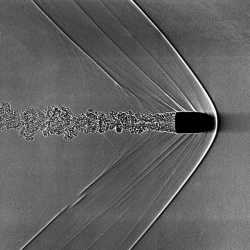Bullet bow shockwave
The bullet bow shockwave is the result of air being greatly compressed at the front-most tip of the bullet as it slices through the air. As the bullet moves forward a broadening wave of compressed air trails out diagonally from the bullet tip. The sides of the bullet create a conical waveform. This conical waveform may be audible to a witness as a whip-crack sound.
A bullet bow shockwave will be heard by any witness as long as the bullet speed is faster than the speed of sound, whether the bullet was fired from a weapon giving off an openly audible muzzle blast, or a mechanically-suppress-fired muzzle (silenced weapon) blast. If a bullet is fired from a silenced weapon, a witness can mistake the bullet bow audible shockwave whip-crack for the weapon muzzle blast audible wave, which is a separate audible event. It might be noted here that if one is involved in such an event, that the sound you hear from a silenced weapon will not be from the point of origin. Most humans will perceive the sound as being omnidirectional or as emanating from the bullet as it passes by.
In History
- This phenomenon may be of primary importance in the "grassy knoll" theory of the Kennedy Assassination.
In fiction
- This effect was visualized in several bullet time scenes in "The Matrix" Trilogy.
